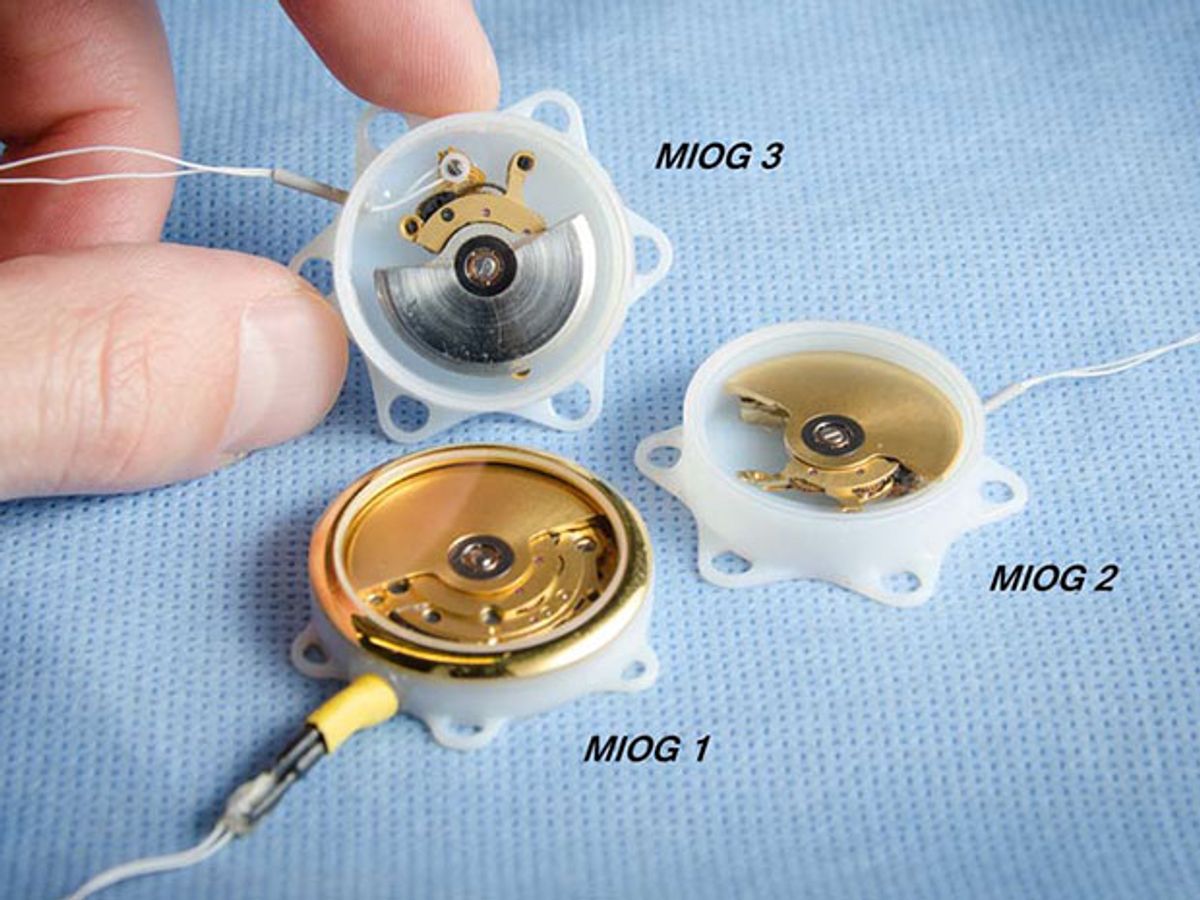When I think of fine Swiss watches, I picture them on the wrists of executives and professional athletes. When some Swiss bioengineers think about such timepieces, lately they envision them implanted on a beating heart.
Researchers at the University Hospital of Bern, in Switzerland, figured out how to modify 250-year-old self-winding watch technology so that timepieces could harvest energy from the pumping motion of a heart. The group has tested it in pigs and found that it generated enough energy to power a pacemaker.
Pacemakers are typically implanted near the pectoral muscle and deliver electrical pulses through a lead to the heart to help control abnormal cardiac rhythms. But they require bulky batteries that inevitably need to be replaced, requiring additional surgeries. A bio-powered device would “give the pacemaker the intrinsic ability to harvest energy continuously inside the body,” says Andreas Haeberlin, a cardiologist and bioengineer at the University Hospital of Bern, and a collaborator on the project.
It could potentially eliminate the need for batteries in other implanted devices such as defibrillators and electrical stimulators. Haeberlin and his colleagues published their work in a pair of papers in September and October, and previously presented their design at a 2014 European Society of Cardiology meeting in Barcelona.
But before they put a ticker on your ticker, they’ll need to better understand how the device affects the heart over time. Haeberlin says there will likely be at least some irritation and accumulation of fluid around the device, which would eventually be resolved by the body, leaving some scars. There’s also the possibility that the motion of the heart at the site of the implant would diminish slightly, he says. “One would have to investigate that,” he says. “We don’t have a good idea of how it would affect the efficiency of the device.”
Haeberlin and Adrian Zurbuchen, a post doc at the University of Michigan, are setting up an animal study to investigate the mid- and long-term effects on the heart, as well as the efficacy of the device. They expect results within three years, Haeberlin says.
In classic self-winding watches, or automatic clockwork, the motions of the wearer’s wrist wind the clock. A weighted, semi-circular metal piece called an oscillating weight swings around a pivot, so that as the wrist moves, the weight is pulled down by gravity. That energy is transferred through a series of gears to a spring that winds the watch.
Haeberlin and his colleagues thought that the motion of a heartbeat would be enough to move the oscillating weight too, and generate energy. The trick, they discovered through a mathematical simulation, was to modify the weight to have a smaller radius and higher mass.
So they borrowed a wristwatch from ETA, a subsidiary of Swatch that’s based in Grenchen, Switzerland. They stripped the timepiece down to the basic machinery, replaced the oscillating weight with a smaller, heavier one they cut out of platinum, and added a microgenerator from an autoquartz watch to convert the mechanical energy to electrical energy.
The device was then hooked up to a pacemaker, encapsulated, and sutured to the heart at six points. When tested in pigs, the ticker generated about 6 microwatts of energy—enough to power the pacemaker.
Of course, if a person has a need for a pacemaker, one can assume his heart isn’t the best at beating. A small back-up battery would likely be required, while the clockwork device serves as the primary energy source, Haeberlin and colleagues wrote in their September paper in IEEE Transactions on Biomedical Circuits and Systems.
The automatic clock is one of many approaches to harvesting power from the heart and other organs in the body. Haeberlin’s colleagues at Bern also developed an intravascular turbine to harvest energy from blood flow. Other groups have harnessed energy from organs using piezoelectric materials. MIT researchers harnessed power from inner ear, where there’s a natural electrochemical potential.
“There are always different approaches to reach the ultimate goal, and I think we all have the same motivation to replace primary batteries” in implanted medical devices, Haeberlin says.
Clockwork might be the most reliable approach because, well, it operates like clockwork. In fact, it was Switzerland’s history of watchmaking and dominance in the luxury market that inspired Haeberlin to use that approach.
And they couldn’t have done it without the help of Swiss watchmakers, he says. “We are not able to modify such highly complex clockwork on our own,” he says. They had expected to find computer models that would give them the information they needed, but instead found that the knowledge rests with the very old, hands-on experience of people in the business. Haeberlin seemed to take pride in that collaboration with the watch industry, calling it bioengineering “the Swiss way.”
Emily Waltz is the power and energy editor at Spectrum. Prior to joining the staff in January 2024, Emily spent 18 years as a freelance journalist covering biotechnology, primarily for the Nature research journals and Spectrum. Her work has also appeared in Scientific American, Discover, Outside, and the New York Times. Emily has a master's degree from Columbia University Graduate School of Journalism and an undergraduate degree from Vanderbilt University. With every word she writes, Emily strives to say something true and useful. She posts on Twitter/X @EmWaltz and her portfolio can be found on her website.



